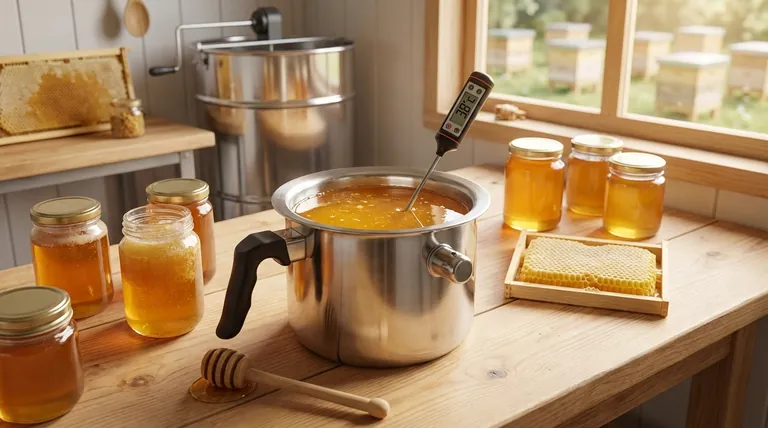Without a doubt, temperature control is the single most critical factor in preserving the quality of honey post-harvest. It directly dictates the honey's texture by preventing crystallization, and more importantly, it protects the delicate enzymes, flavors, and aromas that define its value.
The core challenge with honey is its sensitivity to both cold and heat. Low temperatures cause it to solidify through crystallization, while high temperatures permanently destroy its beneficial compounds and unique sensory profile.

The Two Primary Threats to Honey Quality
To maintain high-quality honey, you must protect it from two distinct temperature-related risks: crystallization from cold and degradation from heat.
Threat 1: Crystallization from Cold
Honey is a supersaturated solution of sugars, primarily glucose and fructose, in water. At lower temperatures, the glucose tends to separate from the water, forming solid crystals.
This process, known as crystallization, is natural but changes the honey's texture from smooth and liquid to thick and granular. While not harmful, most consumers prefer a liquid, pourable product.
Maintaining a steady, warm temperature keeps the glucose fully dissolved, preserving the honey's desired smooth consistency and pourability.
Threat 2: Degradation from High Heat
Excessive heat is far more damaging than cold. Applying heat above 40°C (104°F) begins a process of irreversible degradation.
High temperatures destroy the naturally occurring enzymes (like diastase and invertase) and vitamins in honey, diminishing its nutritional and beneficial properties.
Furthermore, delicate flavor and aroma compounds are volatile and easily destroyed by heat, stripping the honey of its unique character. Overheated honey can become tacky, darker in color, and difficult to digest.
The Principles of Proper Temperature Management
The goal is not simply to heat honey, but to manage its temperature with precision to maintain liquidity without causing harm.
Finding the "Safe Zone"
The ideal temperature range for holding and gently liquefying honey is between 35-40°C (95-104°F).
This range is warm enough to prevent crystallization and ensure the honey flows easily for bottling, but it is safely below the threshold where significant enzymatic and flavor degradation occurs.
The Importance of Gentle, Controlled Heating
How you apply heat is as important as the temperature itself. The best practice is to use gentle, uniform heating.
This is often achieved with equipment like a honey heating tank, which provides controlled, low-wattage warmth. This prevents "hot spots" that can scorch and damage portions of the honey while leaving other parts cold.
Understanding the Trade-offs
Managing honey temperature involves balancing processability against preservation.
The Problem with Zero Heat
Completely avoiding heat may seem like the safest option, but it allows crystallization to occur. This makes the honey difficult to filter, handle, and package, impacting operational efficiency and saleability.
The Danger of "Quick" Heating
The most common mistake is attempting to heat honey too quickly or at too high a temperature to speed up the process. This is a false economy.
Rapid, intense heat leads to irreversible damage, destroying the very qualities that make honey a premium product. It is always better to heat slowly at a lower, controlled temperature.
Making the Right Choice for Your Goal
Your approach to temperature control should align with your final objective.
- If your primary focus is preparing honey for bottling and sale: Maintaining a consistent temperature between 35-40°C (95-104°F) is critical to ensure pourability and prevent crystallization in the final product.
- If your primary focus is preserving maximum nutritional and sensory value: Never allow your honey to exceed 40°C (104°F) and always use gentle, indirect heating methods to protect its delicate enzymes and compounds.
- If your primary focus is long-term bulk storage: You can allow the honey to crystallize in storage, but you must plan for a gentle, slow warming period before it can be processed or packaged.
Ultimately, mastering temperature control gives you direct command over the final texture, flavor, and quality of your honey.
Summary Table:
| Threat | Temperature Range | Effect on Honey | Key Takeaway |
|---|---|---|---|
| Crystallization (Cold) | Below 35°C (95°F) | Becomes thick, granular, and difficult to pour. | Maintains pourability but is a natural process. |
| Degradation (Heat) | Above 40°C (104°F) | Destroys enzymes, vitamins, and unique flavors; darkens color. | Causes irreversible damage to quality and value. |
| Ideal "Safe Zone" | 35-40°C (95-104°F) | Prevents crystallization while preserving all beneficial properties. | The optimal range for processing and storing high-quality honey. |
Achieve Perfect Honey Quality with Professional Equipment
For commercial apiaries and distributors, precise temperature control is not just a recommendation—it's a business necessity. Compromising on quality can directly impact your brand reputation and profitability.
HONESTBEE supplies the robust, wholesale-focused beekeeping equipment you need to master this critical process. Our range of honey heating tanks and temperature control solutions are designed for commercial-scale operations, ensuring gentle, uniform heating that protects your honey's premium value.
Let us help you safeguard your product's quality and maximize your operational efficiency.
Contact HONESTBEE today to discuss the right equipment for your commercial beekeeping or distribution needs.
Visual Guide

Related Products
- Beeswax Melter for Candle Making Honey Bee Wax Melter
- Stainless Steel Manual Honey Press with Guard for Pressing Honey and Wax
- Steam Beeswax Melter Wax Warmer for Wax Processing
- 10L Stainless Steel Electric Honey Press Machine
- Modern Honeycomb Pattern Wooden Honey Dipper for Stirring and Drizzling
People Also Ask
- What makes polyurethane foam environmentally friendly? The Surprising Benefits of a Durable, Inert Material
- What is the best way to melt beeswax for candles? The Safest Method for Professional Results
- What are the benefits of using a professional wax melter? Achieve Consistent, Scalable, and Safe Production
- What do you use a wax melter for? From Home Fragrance to Professional Beekeeping
- What are the primary products of honey bee farming besides honey? Discover the Hive's Hidden Treasures



















